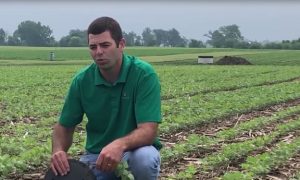PFR is more than just research
By Dusty Sonnenberg, CCA, Ohio Field Leader: a project of the Ohio Soybean Council and soybean checkoff.
At the Beck’s PFR (Practical Farm Research) site near London, Ohio PFR is more than just research. “The Ohio PFR site strives to be a respected member of the community and accurate representation of the Beck family,” said Jared Chester, Practical Farm Research Location Lead. “The London, Ohio PFR location includes 130 acres of replicated plots, along with another 85 acres of testing in larger field scale settings that are managed with The Ohio State University.”

Beck’s PFR locations are representative of the agricultural production commonly found in the area. “The London site has 70 different replicated studies which include: corn, soybeans, wheat, and double crop soybeans. In addition, we have some demonstration plots that are conducted for training and observation only” said Chester. “We are using replicated testing to answer questions and provide recommendations to help farmers succeed.”
Beck’s has six testing locations across five states, as well as cooperator sites in an additional three states. Practical Farm Research started in 1964. Last year Beck’s PFR had 110 studies testing over 350 products and systems across 800 dedicated acres in the Midwest. Some of the research is specific to the site and conducted as individual location studies, however most studies are at multiple locations to increase confidence in the results.
At the London PFR location, several new studies are building on previous research. “We have learned that early planted soybeans pay consistently,” said Chester. “We are now looking at a possible variety response to planting early. There is an old saying, “Don’t plant an early maturity soybean late.” We are testing that by planting four different maturities on three different planting dates which include mid-April, May, and early June. We are also studying the effect that planting date has on fungicide. We want to learn if a R3 fungicide application will show the same positive return on investment depending on the planting date and yield potential.”
Each year there are a number of fields in Ohio that need replanted or spotted in. “Beck’s PFR is conducting a Replant Threshold Study to first determine when there is a reduced and sporadic stand, how low of a population will still produce optimum yield,” said Chester. The other new study around replant is a Replant Spotting in Study. “When the decision has been made to replant we want to be able to help farmers decide what population they should target on the replant pass. We are also looking at what happens if you leave the reduced stand or decide to completely tear it up and start over.”
While many seed companies do variety or hybrid trials in their research, Beck’s PFR also evaluates equipment and systems for planting. “We are looking at the new closing system from Precision Planting and using spike closing wheels on soybeans,” said Chester. “A lot of the equipment and technology we have on our corn planter is showing the same benefit for our soybeans. Hydraulic downforce and row cleaners have been used in corn with success, and we want to evaluate how it can potentially improve soybean stands and emergence.” Another new equipment related study is singulating soybeans. The Indiana site is using a custom built 10” planter to singulate soybeans in their high yield attempt.
Weed control is a concern every year on every farm. Beck’s PFR conducts herbicide studies using the various trait platforms. “This year we will have the XtendFlex Soybeans in our show plot at the London PRF site,” said Chester. “We also conduct herbicide additive studies and demonstration plots to help farmers make decisions for their farms.” Each year Beck’s publishes a Recommended Soybean Herbicide Programs booklet to provide growers with programs and options for weed control in soybeans. The Beck’s Recommended Soybean Herbicide Program Guide includes two and three pass program options for Roundup Ready 2 Xtend®, LibertyLink®GT27™, Enlist E3™, and non-GMO soybean platforms. It has fall burndown recommendations, a list of common herbicides and their plant-back restrictions, an in-depth look at five tough-to-control weeds, and a table of rainfast times for common products. It also provides growers with herbicide study results from the PFR program. “Our goal is to provide farmers a resource to help them develop an effective soybean herbicide program tailored to the weeds they battle and trait platforms they utilize,” said Chester.
Conducting research is often times a task that farmers cannot squeeze into their already overloaded schedule. “Having resources like Beck’s PFR is a great tool for all farmers to use to help make decisions and improve profitability. If you are looking at trying something new on your farm be sure to look thru the PFR book or search the online version at www.beckshybrids.com,” said Chester. “The odds are Beck’s has tried it.”